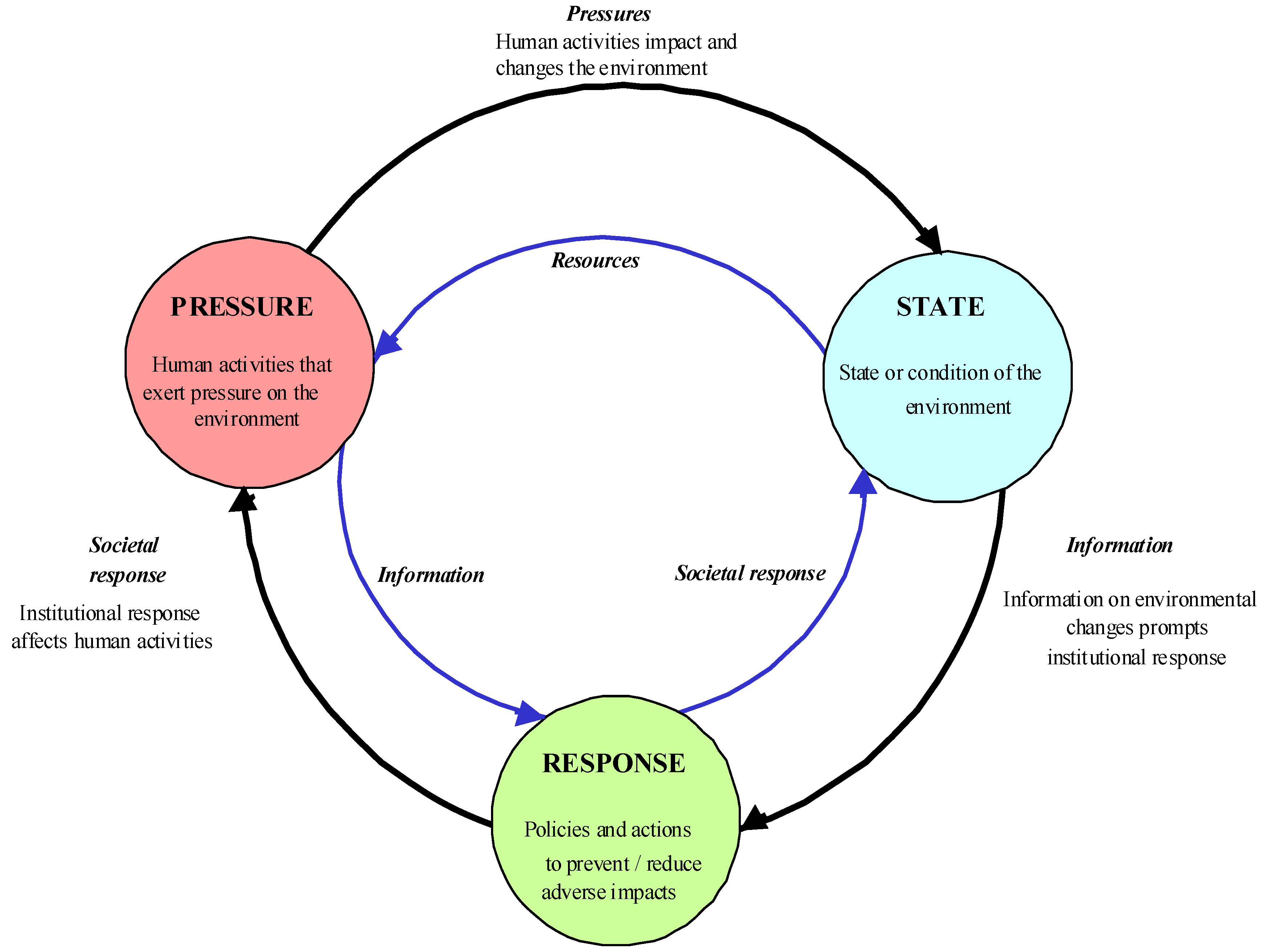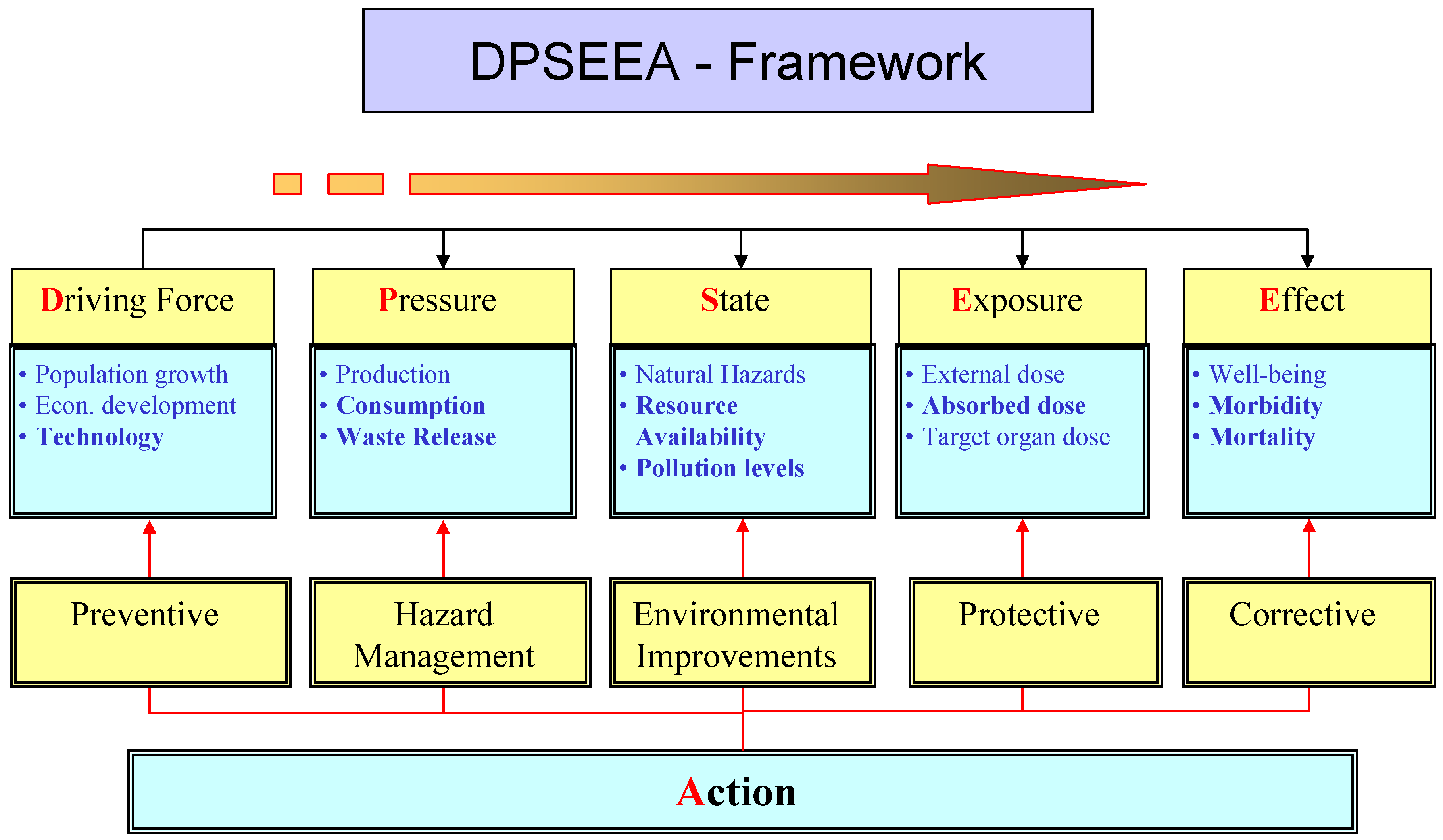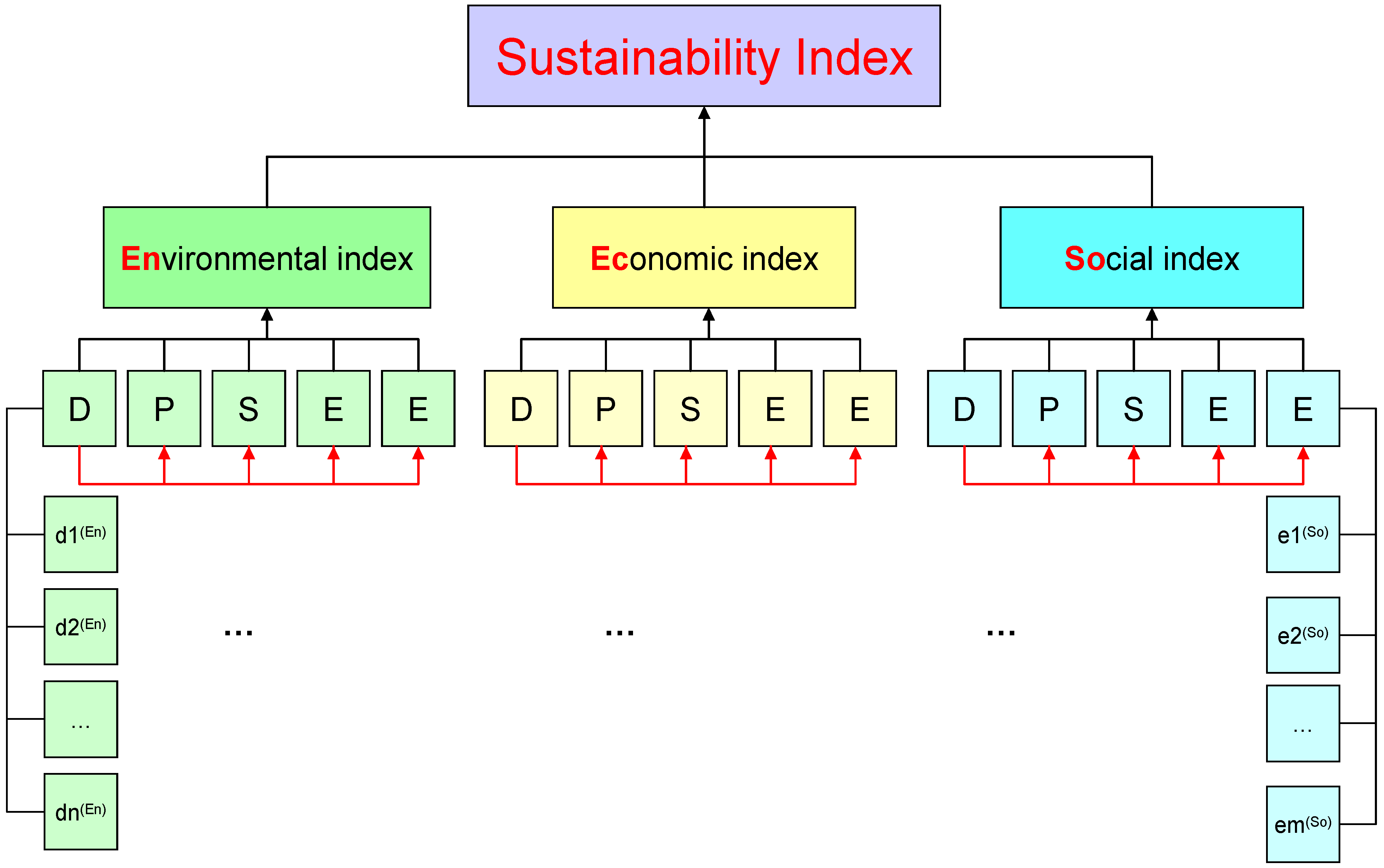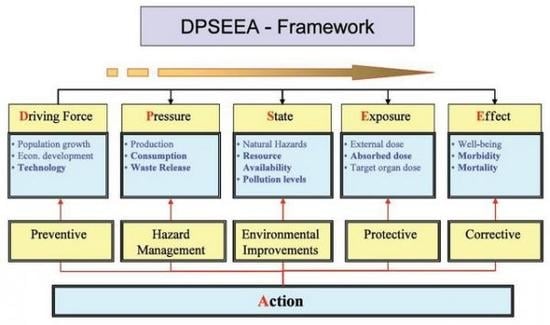Linkage-Based Frameworks for Sustainability Assessment: Making a Case for Driving Force-Pressure-State-Exposure-Effect-Action (DPSEEA) Frameworks
Abstract
:1. Introduction
1.1. Definition
1.2. Sustainable Development
2. Sustainability Metrics
| Data/Variables | Indicators | Indices | Performance assessment criteria (C) | Objectives (O) | ||
|---|---|---|---|---|---|---|
| Environment (O1) | Economics (O2) | Society (O3) | ||||
| Basic data that can be directly measured or monitored. | Each performance indicator derived from aggregation of various basic parameters | Each performance criteria derived from aggregation of various indicators | Health (C1) | ∗ | ∗ | |
| Safety (C2) | ∗ | ∗ | ||||
| Economic development (C3) | ∗ | ∗ | ∗ | |||
| Social equity (C4) | ∗ | ∗ | ||||
| Environmental quality (C5) | ∗ | ∗ | ∗ | |||
| Ecology (C6) | ∗ | |||||
| Technical feasibility (C7) | ∗ | ∗ | ||||
- ➢
- encompassing all relevant aspects of sustainability performance
- ➢
- non-overlapping (i.e., mutually exclusive)
- ➢
- easy to understand and interpret
- ➢
- as few in numbers as possible
- ➢
- verifiable
- ➢
- defined for a given time period, and
- ➢
- universal enough to be measured in diverse conditions.
| Areas | Name of Index Approach | Categories |
|---|---|---|
| Innovative, knowledge and technology indices | Summary innovation index |
|
| Development indices | Human development index (HDI) |
|
| Index of sustainable and economic welfare |
| |
| Market and economy-based indices | Green Net National Product (EDP) and System of integrated Environmental and Economic Accounting (SEEA) |
|
| Eco-system based indices | Sustainability performance index (SPI) |
|
| Eco-index methodology |
| |
| Living Planet index |
| |
| Ecological Footprint (EF) |
| |
| Composite sustainability performance indices for industries | Composite Sustainable Development Index |
|
| Composite Sustainability Performance index |
| |
| G score method |
| |
| ITT Flgyt Sustainability Index |
| |
| Product-based sustainability indices | Life Cycle Index (LInx) |
|
| Environmental indices for policies, nations and regions | Environmental Sustainability Index |
|
| Environmental Quality Index |
| |
| Environmental Performance Index |
| |
| Environmental Vulnerability Index |
| |
| Environmental indices for industries | Eco-indicator 99 |
|
| Green Pro-1 [20-21] |
|
3. Sustainability Assessment Frameworks
- ➢
- Objective-based (e.g., strategic environmental assessment (SEA))
- ➢
- Impact-based (e.g., environmental impact assessment (EIA), sustainability impact assessment (SIA), TBL assessment)
- ➢
- Influence-based (e.g., Transport Canada framework [24])
- ➢
- Process-based or stakeholder-based (e.g., USDOE “Ten Steps to Sustainability” [25])
- ➢
- Material flow accounting and Life cycle assessment (e.g., LInX [26])
- ➢
- Linkages-based (e.g., pressure-state-response (PSR), driving force-pressure-state-impact-response ( DPSIR))
3.1. Objective-Based Frameworks
3.2. Impact-Based Frameworks
| Frameworks | Main Features |
|---|---|
| Objective-based |
|
| Impact-based |
|
| Influence-based |
|
| Process/stakeholder-based |
|
| Material flow assessment/Life cycle assessment |
|
| Linkage-based |
|
3.3. Influence-Based Frameworks
3.4. Process- or Stakeholder-Based Frameworks
3.5. Material Flow/Accounting and Life Cycle Assessment Framework
- ➢
- Define goal and scope helps to understand the purpose and the scope of the study and requires using system boundaries.
- ➢
- Inventory analysis accounts for energy and raw material and discharges from all activities, products, and processes.
- ➢
- Impact analysis determines the environmental impacts due to activities, products, and processes.
- ➢
- Improvement assessment identifies the possibilities for improving the performance of the system.
3.6. Linkage-Based Frameworks
4. Types of Linkage-Based Frameworks
4.1. Pressure-State-Response

4.2. Driver-Pressure-State-Impact-Response
4.3. Driving Force-Pressure-State-Exposure-Effects-Action (DPSEEA)

5. Proposed Integrated Framework for Sustainability Assessment

- ➢
- It cannot work effectively if the evidence for causal linkages is missing or vague
- ➢
- It leads to oversimplification of spatial and temporal interactions that results in poorly informed management decisions
- ➢
- It oversimplifies inter-linkages among issues and factors. Often, it is ambiguous as to whether the issue measured by an indicator represents a driving force or a pressure. Sometimes there are multiple pressures for most states, and multiple states arising from most pressures, creating difficulties in identifying indicators.
6. Linkage-Based Frameworks: An Example of Universities
7. Discussion and Conclusions
| DPSEEA | DPSIR | PSR | Factors |
|---|---|---|---|
| Driving force | Driver | N/A |
|
| Pressure | Pressure | Pressure |
|
| State | State | State |
|
| Exposure | N/A | N/A |
|
| Effect | Impact |
| |
| Action | Response | Response |
|
Acknowledgements
References
- WCED. Our Common Future (The Brundtland Report); Oxford University Press: Oxford, UK, 1987. [Google Scholar]
- Kenway, S.; Howe, C.; Maheepala, S. Triple Bottom Line Reporting of Sustainable Water Utility Performance; IWA Publishing: London, UK, 2007. [Google Scholar]
- Becker, B. Sustainability assessment: A review of values, concepts, and methodological approaches. The World Bank: Washington, DC, USA, 1997; p. 66. [Google Scholar]
- Gibson R.B. Specification of Sustainability-Based Environmental Assessment Decision Criteria and Implications for Determining ‘‘Significance’’ in Environmental Assessment; Canadian Environmental Assessment Agency, 2000. Available online: http://www.ceaa.gc.ca/015/001/009/1_e.htm (accessed December 12, 2008).
- Jabareen, Y. A new conceptual framework for sustainable development. Environ. Dev. Sustain. 2008, 10, 179–192. [Google Scholar] [CrossRef]
- Sahely, H.R.; Kennedy, C.A.; Adams, B.A. Developing sustainability criteria for urban infrastructure systems. Can. J. Civ. Eng. 2005, 32, 72–85. [Google Scholar] [CrossRef]
- Toxic chemicals and children’s health in North America: a call for efforts to determine the sources, levels of exposure, and risks that industrial chemicals pose to children’s health; Commission for Environmental Cooperation: Montréal, Canada, 2006.
- Loucks, D.P.; Stakhiv, E.Z.; Martin, L.R. Sustainable water resources management. J. Water Res. Planning Manage. 2000, 126, 43–47. [Google Scholar] [CrossRef]
- Pearce, D.; Turner, R.K. Economics of Natural Resources and the Environment; Johns Hopkins University Press: Baltimore, MD, USA, 1990; p. 44. [Google Scholar]
- Pope, J.; Annandale, D.; Morrison-Saunders, A. Conceptualizing sustainability assessment. Environ. Impact Asses. Rev. 2004, 24, 595–616. [Google Scholar] [CrossRef]
- Barrera-Roldan, A.; Saldivar-Valdes, A. Proposal and application of a sustainable development index. Ecol. Indic. 2002, 2, 251–256. [Google Scholar] [CrossRef]
- Niemeijer, D.; de Groot, R. Framing environmental indicators: moving from causal chains to causal networks. Environ. Dev. Sus. 2008, 10, 89–106. [Google Scholar] [CrossRef]
- Alegre, H. Performance Indicators for Water Supply Systems–Current Trends and On-going Projects, Drought Management Planning in Water Supply Systems; Carbera, E., Garcia-Serra, J., Eds.; Kluwer Academic Publishers: the Netherlands, 1999; pp. 148–178. [Google Scholar]
- Foxon, T.J.; McIlkenny, G.; Gilmour, D.; Oltean-Dumbrava, C.; Souter, N.; Ashley, R.; Butler, D.; Pearson, P.; Jowitt, P.; Moir, J. Sustainability criteria for decision support in the UK water industry. J. Environ. Planning Manage. 2002, 45, 285–301. [Google Scholar] [CrossRef]
- Maclaren, V. Developing Indicators of Urban Sustainability: A Focus on the Canadian Experience; Intergovernmental Committee on Urban and Regional Research (ICURR) Press: Toronto, ON, Canada, 1996. [Google Scholar]
- Alberti, M. Measuring urban sustainability. Environ. Impact Assess. Rev. 1996, 16, 381–424. [Google Scholar] [CrossRef]
- Linkage Methods for Environment and Health Analysis. General Guidelines; WHO/EHG/95.26. World Health Organization: Geneva, Switzerland, 1996. Available online: http://www.who.int/ mediacentre/events/IndicatorsChapter7.pdf (accessed December 7, 2008).
- Edwin, K.L.T. Challenges in using environmental indicators for measuring sustainability practices. J. Environ. Eng. Sci. 2002, 1, 417–425. [Google Scholar] [CrossRef]
- Singh, R.S.; Murty, H.R.; Gupta, S.K.; Dikshit, A.K. An overview of sustainability assessment methodologies. Ecol. Indic. 2009, 9, 189–212. [Google Scholar] [CrossRef]
- Sadiq, R.; Khan, F.I.; Veitch, B. Greenpro-I: a risk-based life cycle assessment methodology for green and clean process selection and design decision-making. Comput. Chem. Eng. 2005, 29, 1023–1039. [Google Scholar] [CrossRef]
- Khan, F.I.; Sadiq, R.; Husain, T. GreenPro-I: A risk-based life cycle assessment and decision-making methodology for process plant design. Environ. Model. Software. 2002, 17, 669–691. [Google Scholar] [CrossRef]
- Jeon, C.M.; ASCE, S.M.; Sdjo Amekudzi, M. Addressing sustainability in transportation system: definitions, indicators, and metrics. J. Infr. Syst. ASCE 2005, 11, 31–50. [Google Scholar] [CrossRef]
- Guio-Torres, D.M. Sustainability Indicators for Assessment of Urban Water Systems: The Need for A Common Ground. First SWITCH Scientific Meeting; University of Birmingham: Birmingham, UK, 9–10 January 2006. Available online: http://www.switchurbanwater.eu/outputs/pdfs/WP1-1_PAP_Sustainability_indicators_ for_assessment_of_UWS.pdf (accessed December 15, 2008).
- Sustainable Development Strategy 2001–2003; Transport Canada: Ottawa, OM, Canada, 2001. Available online: http://www.tc.gc.ca/pol/en/acs/SD/sds0406/appendixC.htm (accessed December 15, 2008).
- Environmental Defense. Environmental Sustainability Kit; Pollution Prevention Alliance: New York, NY, USA, 1999. [Google Scholar]
- Khan, F.I.; Sadiq, R.; Veitch, B. Life cycle index (LInX): a new indexing procedure for process, and product design and decision-making. J. Cleaner Prod. 2004, 12, 59–76. [Google Scholar] [CrossRef]
- Pintér, L.; Hardi, P.; Bartelmus, P. Indicators of Sustainable Development: Proposals for a Way Forward (Discussion Paper Prepared under a Consulting Agreement on behalf of the UN Division for Sustainable Development); International Institute for Sustainable Development (IISD): New York, NY, USA, 2005. [Google Scholar]
- Litman, T. Sustainable Transportation Indicators - A Recommended Research Program for Developing Sustainable Transportation Indicators and Data; Victoria Transport Policy Institute (VTPI), 2008. Available online: http://www.vtpi.org/sustain/sti.pdf (accessed December 15, 2008).
- Ashley, R.; Hopkinson, P. Sewer systems and performance indicators—Into the 21st century. Urban Water. 2002, 4, 123–135. [Google Scholar] [CrossRef]
- Pearce, A.R.; Vanegas, J.A. Defining sustainability for built environment systems. Int. J. Environ. Technol. Manage. 2002, 2, 94–113. [Google Scholar] [CrossRef]
- Hacking, T.; Guthrie, P. A framework for clarifying the meaning of Triple Bottom Line, Integrated, and Sustainability Assessment. Environ. Impact Assess. Rev. 2008, 28, 73–89. [Google Scholar] [CrossRef]
- The Talloires Declaration; UNESCO: Talloires, France, 1990.
- Velazquez, L.; Munguia, N.; Platt, A.; Taddei, J. Sustainable university: what can be the matter? J. Cleaner Prod. 2006, 14, 810–819. [Google Scholar] [CrossRef]
- Wernick, I.K.; Irwin, F.H. Material Flow Accounts: A Tool for Making Environmental Policy; WRI Material Resource project: Washington, DC, USA, 2005. Available online: http://pdf.wri.org/WRI_MFA_Policy.pdf (accessed December 10, 2008).
- A Technological Framework for Life Cycle Assessment; Society of Environmental Toxicology and chemistry (SETAC): Washington, DC, USA, 1991.
- Khan, F.I.; Raveender, V.; Husain, T. Effective environmental management through life cycle assessment. J. Loss Prev. Process Ind. 2002, 15, 455–466. [Google Scholar] [CrossRef]
- Friend, A.; Rapport, D. Towards a Comprehensive Framework for Environmental Statistics: a Stress-Response Approach, Statistics Canada, 1979.
- Concepts and Methods of Environment Statistics: Statistics of the Natural Environment–A Technical Report; United Nations: New York, NY, USA, 1991.
- Environmental Indicators: A Preliminary Set; OECD: Paris, France, 1991.
- Towards Sustainable Development: Indicators to Measure Progress. Organisation for Economic Co-operation and Development (OECD) Conference, Rome, Italy, December 15–17, 1999.
- Environment in the European Union at the Turn of the Century; Report 2; European Environment Agency: Copenhagen, Denmark, 1999.
- Environmental Signals; Report 8; European Environment Agency: Copenhagen, Denmark, 2001.
- Draft Report on the Environment; Report EPA 260-R-02-006; United States Environmental Protection Agency: Washington, DC, USA, 2003.
- World Resources 2005: The Wealth of the Poor, Managing Ecosystems to Fight Poverty; World Resources Institute: Washington, DC, USA, 2005.
- Indicators of Sustainable Development—Framework and Methodologies; United Nations: New York, NY, USA, 1996.
- Gilbert, R.; Tanguay, H. Brief Review of Some Relevant Worldwide Activity and Development of an Initial Long List of Indicators; Sustainable Transportation Performance Indicators (STPI) Project, Center for Sustainable Transportation (CST): Toronto, ON, Canada, 2000. [Google Scholar]
- Corvalán, C.F.; Kjellström, T.; Smith, K.R. Health, environment, and sustainable development—Identifying links and indicators to promote action. Epidemiology 1999, 10, 656–660. [Google Scholar] [CrossRef] [PubMed]
- Environment and Health Indicators for Europe. A Pilot Indicator-Based Report; WHO Regional Office for Europe: Copenhagen, Denmark, 2004.
- Developing National Environmental Health Indicators for New Zealand. Khan, R.; Voice, T.; Philips, D. (Eds.) Ministry of Health New Zealand: Auckland, 2005.
- von Schirnding, Y. Health in Sustainable Development Planning: the Role of Indicators; World Health Organisation: Geneva, Switzerland, 2002. [Google Scholar]
- The Swansea Declaration; UNESCO: Kyoto, Japan, 1993.
- Kyoto Declaration; The 9th round table meeting of IAU. UNESCO: Kyoto, Japan, 1993. Available online: www.unesco.org/iau/sd/sd_dkyoto.html (accessed December 18, 2008).
- Lozano, R. A tool for a graphical assessment of sustainability in universities (GASU). J. Cleaner Prod. 2006, 14, 963–972. [Google Scholar] [CrossRef]
- Sadler, B. A Framework for Environmental Sustainability Assessment and Assurance. In Handbook of Environmental Impact Assessment; Petts, J., Ed.; Blackwell: Oxford, UK, 1999; Vol. 1, pp. 12–32. [Google Scholar]
- Wilkinson, D.; Fergusson, M.; Bowyer, C.; Brown, J.; Ladefoged, A.; Monkhouse, C.; Zdanowicz, A. Sustainable Development in the European Commission’s Integrated Impact Assessments for 2003; Institute for European Environmental Policy: London, UK, 2004; Available online: http://www.ieep.eu/publications/pdfs/2004/sustainabledevelopmentineucommission.pdf (accessed December 17, 2008).
- Waheed, B.; Khan, F.; Veitch, B. A quantitative assessment of sustainability for higher education institutions: an application of DPSEEA framework. J. Cleaner Prod. 2009. (in review). [Google Scholar]
© 2009 by the authors; licensee Molecular Diversity Preservation International, Basel, Switzerland. This article is an open-access article distributed under the terms and conditions of the Creative Commons Attribution license (http://creativecommons.org/licenses/by/3.0/).
Share and Cite
Waheed, B.; Khan, F.; Veitch, B. Linkage-Based Frameworks for Sustainability Assessment: Making a Case for Driving Force-Pressure-State-Exposure-Effect-Action (DPSEEA) Frameworks. Sustainability 2009, 1, 441-463. https://0-doi-org.brum.beds.ac.uk/10.3390/su1030441
Waheed B, Khan F, Veitch B. Linkage-Based Frameworks for Sustainability Assessment: Making a Case for Driving Force-Pressure-State-Exposure-Effect-Action (DPSEEA) Frameworks. Sustainability. 2009; 1(3):441-463. https://0-doi-org.brum.beds.ac.uk/10.3390/su1030441
Chicago/Turabian StyleWaheed, Bushra, Faisal Khan, and Brian Veitch. 2009. "Linkage-Based Frameworks for Sustainability Assessment: Making a Case for Driving Force-Pressure-State-Exposure-Effect-Action (DPSEEA) Frameworks" Sustainability 1, no. 3: 441-463. https://0-doi-org.brum.beds.ac.uk/10.3390/su1030441





